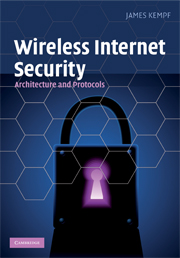Book contents
- Frontmatter
- Contents
- Preface
- Acknowledgements
- 1 Security basics
- 2 Network system architecture basics
- 3 Cryptographic algorithms and security primitives
- 4 Wireless IP network access control
- 5 Local IP subnet configuration and address resolution security
- 6 Security for global IP mobility
- 7 Location privacy
- References
- Index
7 - Location privacy
Published online by Cambridge University Press: 06 July 2010
- Frontmatter
- Contents
- Preface
- Acknowledgements
- 1 Security basics
- 2 Network system architecture basics
- 3 Cryptographic algorithms and security primitives
- 4 Wireless IP network access control
- 5 Local IP subnet configuration and address resolution security
- 6 Security for global IP mobility
- 7 Location privacy
- References
- Index
Summary
Users of wireless Internet services have a reasonable expectation that their activities are protected from eavesdropping and snooping by attackers even when confidentiality protection is not in use. All Internet traffic contains identifiers that allow application, transport, and network protocols to keep track of important entities and interactions. From a technical standpoint, privacy means that these identities are not traceable back to information allowing an eavesdropper to identify the user. If the identities are additionally masked from one or both endpoints in the protocols, then the communication is also anonymous. Privacy and anonymity are important security properties for certain types of transactions, and are different from confidentiality discussed in Chapter 1. The contents of a communication between two hosts can be protected by encryption to provide confidentiality from eavesdropping, while the identities of the two hosts are still exposed through unencrypted information necessary for routing. For wireless Internet communication, location privacy means that the geographic location of a particular wireless terminal cannot be inferred from the contents of the terminal's traffic or from unencrypted identifiers. As for general privacy, location anonymity means that the location is masked from endpoints as well as from eavesdroppers. Location privacy and location anonymity are issues for fixed terminals too, but because users typically carry wireless terminals with them, the risk for users is larger with wireless terminals.
In the next section, we briefly discuss the threat against general privacy of communications on the Internet and specific threats against location privacy for wireless terminals.
- Type
- Chapter
- Information
- Wireless Internet SecurityArchitecture and Protocols, pp. 169 - 198Publisher: Cambridge University PressPrint publication year: 2008



